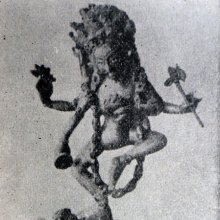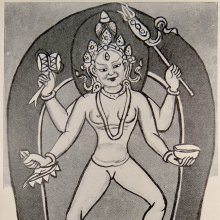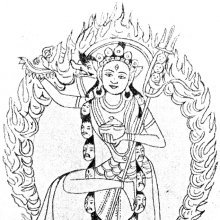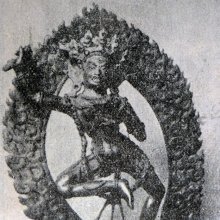Khandaroha, Khaṇḍarohā: 6 definitions
Introduction:
Khandaroha means something in Buddhism, Pali, Hinduism, Sanskrit. If you want to know the exact meaning, history, etymology or English translation of this term then check out the descriptions on this page. Add your comment or reference to a book if you want to contribute to this summary article.
Images (photo gallery)
In Buddhism
Tibetan Buddhism (Vajrayana or tantric Buddhism)
Source: archive.org: The Indian Buddhist IconographyKhaṇḍarohā (खण्डरोहा) refers to one of the four Ḍākinī Goddesses, as mentioned in the 5th-century Sādhanamālā (a collection of sādhana texts that contain detailed instructions for rituals).—In this group of Goddesses are included the names of [viz., Khaṇḍarohā] who are widely mentioned in the Tantric works of rituals. In the sambara-maṇḍala of the Niṣpannayogāvalī their names are mentioned as companion deities of Sambara. Again, in the ṣaṭcakravarti-maṇḍala they are mentioned as companion deities. But their forms are found described only in the Sādhanamālā. According to this authority they [viz., Khaṇḍarohā] are all alike in appearance holding identical symbols.
Source: Wisdomlib Libary: Vajrayogini1) Khaṇḍarohā (खण्डरोहा, “elephant-faced”) is the name of the goddess found on the western petal of the vārāhyabhyudaya-maṇḍala, according to the Vārāhyabhyudayatantra (largerly extracted from the 10th century Abhidhānottaratantra). The central deity of the vārāhyabhyudaya-maṇḍala is the twelve-armed Vajravarāhī, which is modeled upon the twelve-armed Cakrasaṃvara, thus inhibiting many similar iconographical features.
Khaṇḍarohā is to be visualised by the practitioner as a fierce and therianthropic (half-beast, half-human) goddess having three eyes, loose hair and dancing naked in the ardhaparyaṅka pose, with Bhairava and Kālarāri beneath their feet. They are depicted as having four arms, holding a skull and staff in two arms while holding the head of Brahmā and a chopper in the other two arms.
2) Khaṇḍarohā (खण्डरोहा) is also the goddess presiding over one of the six petals of the western lotus of the vārāhyabhyudaya-maṇḍala, according to the Vārāhyabhyudayatantra (largerly extracted from the 10th century Abhidhānottaratantra). These six petals are presided over by a kuleśvarī (presiding lady) named Tārā.
Khaṇḍarohā is associated with the sacred site (pīṭha) named Gṛhadevatā. All the goddess of the western lotus petals are to be visualised as dancing naked and being half-male / half-female (ardhanarīśvarī) with their two sides being red and yellow. In their four arms they brandish a bowl and staff, with a ḍamaru and their familial attribute.
Source: academia.edu: A Critical Study of the Vajraḍākamahātantrarāja (II)Khaṇḍarohā (खण्डरोहा) is the name of a Ḍākinī (‘sacred girl’) presiding over Gṛhadevatā: one of the four Melāpaka (‘sacred spot’) present within the Kāyacakra (‘circle of body’) , according to the 9th-centruy Vajraḍākatantra. The Kāyacakra is one of three Cakras within the Tricakra system which embodies twenty-four sacred spots or districts resided over by twenty-four Ḍākinīs (viz., Khaṇḍarohā) whose husbands abide in one’s body in the form of twenty-four ingredients (dhātu) of one’s body.
Khaṇḍarohā has for her husband the hero (vīra) named Ratnavajra. She is the presiding deity of Gṛhadevatā and the associated internal location are the ‘anus’ and the bodily ingredient (dhātu) is the ‘pus’.
Source: academia.edu: The Structure and Meanings of the Heruka MaṇḍalaKhaṇḍarohā (खण्डरोहा) refers to one of the twenty-four Ḍākinīs positioned at the padma (lotus) in the middle of the Herukamaṇḍala, according to the 10th century Ḍākārṇava chapter 15. Accordingly, between the west and south (of the heruka-maṇḍala) are six Ḍākinīs who are half red and half yellow in color. They [viz., Khaṇḍarohā] are headed by the major four Ḍākinīs of the Cakrasaṃvara tradition. They stand in the Pratyālīḍha posture and, except for the body posture, their physical features and objects that they hold are the same as Vajravārāhīs.
Khaṇḍarohā (खण्डरोहा) is also mentioned [two times] as a Ḍākinī who, together with the Vīra (hero) named Padmaḍāka [and Ratnavajra] forms two of the 36 pairs situated in the Vajracakra. Accordingly, the vajracakra refers to one of the four divisions of the sahaja-puṭa (‘innate layer’), situated within the padma (lotus) in the middle of the Herukamaṇḍala. The 36 pairs of Ḍākinīs [viz., Khaṇḍarohā] and Vīras each have one face and four arms; they hold a skull bowl, a skull staff, a small drum and a knife; they are dark-bluish-black in color.
Source: OSU Press: Cakrasamvara SamadhiKhaṇḍarohā (खण्डरोहा) (red) refers to one of the four essence Yoginīs of the Saṃvaramaṇḍala of Abhayākaragupta’s Niṣpannayogāvalī, p. 45 and n. 145; (Cf. Cakrasaṃvaratantra, Gray, David B., 2007).—The Cakrasaṃvara-maṇḍala has a total of sixty-two deities. [...] The four essence Yoginīs, Ḍākinī (blue), Lāmā (green), Khanḍarohā (red), and Rūpiṇī (yellow), in counter-clockwise order, east, north, west, and south, in the primary directions.—Khaṇḍarohā is associated with the Bodhipakṣa of dharma-smṛtyupasthāna (“mindfulness of nature”).

Tibetan Buddhism includes schools such as Nyingma, Kadampa, Kagyu and Gelug. Their primary canon of literature is divided in two broad categories: The Kangyur, which consists of Buddha’s words, and the Tengyur, which includes commentaries from various sources. Esotericism and tantra techniques (vajrayāna) are collected indepently.
Languages of India and abroad
Sanskrit dictionary
Source: Cologne Digital Sanskrit Dictionaries: Edgerton Buddhist Hybrid Sanskrit DictionaryKhaṇḍarohā (खण्डरोहा).—name of a yoginī or similar demoness: Sādhanamālā 425.13; 427.7; 439.10.
Sanskrit, also spelled संस्कृतम् (saṃskṛtam), is an ancient language of India commonly seen as the grandmother of the Indo-European language family (even English!). Closely allied with Prakrit and Pali, Sanskrit is more exhaustive in both grammar and terms and has the most extensive collection of literature in the world, greatly surpassing its sister-languages Greek and Latin.
See also (Relevant definitions)
Full-text (+1): Ratnavajra, Grihadevata, Lama, Dakini, Jnanasambhara, Vajrapunya, Sarvavarana, Kleshashanti, Malapanaya, Kleshopaklesha, Upakleshashanti, Vajracakra, Padmadaka, Raktardha, Shaundini, Pitardhika, Raktardhaka, Pitardha, Pitardhaka, Tara.
Relevant text
Search found 1 books and stories containing Khandaroha, Khaṇḍarohā; (plurals include: Khandarohas, Khaṇḍarohās). You can also click to the full overview containing English textual excerpts. Below are direct links for the most relevant articles:



